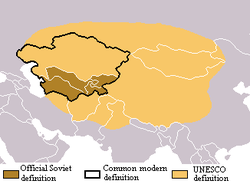East Asia
East Asia or Eastern Asia is part of the continent Asia. East Asia covers about 6,640,000 km2 (2,560,000 sq mi), or 15% of the continent.
These are the 6 countries and 2 territories in East Asia:
- People's Republic of China
- Hong Kong (territory)
- Japan
- North Korea
- South Korea
- Macao (territory)
- Mongolia
- Republic of China (Taiwan)
Population
About 1,575,784,500 people live in East Asia (as of 2010[update]). most of them live in China.
| Countries and territories | Area km² | Population | Population density per km² |
HDI (2010) | Capital |
|---|---|---|---|---|---|
| 9,596,961 | 1,339,724,852 | 138 | 0.663 | Beijing | |
| 1,104 | 7,061,200 | 6,390 | 0.862 | Hong Kong | |
| 377,930 | 127,950,000 | 337 | 0.884 | Tokyo | |
| 30 | 556,800 | 18,662 | No Data | Macau | |
| 1,564,100 | 2,809,600 | 2 | 0.622 | Ulaanbaatar | |
| 120,538 | 24,346,000 | 198 | No Data | Pyongyang | |
| 99,828 | 48,988,833 | 500 | 0.877 | Seoul | |
| 36,188 | 23,174,528 | 639 | 0.868 | Taipei |
East Asia Media
Map showing the boundary of the 13th-century Mongol Empire compared to today's Mongols
Colonies and spheres of influence in East Asia and Oceania, circa 1914
Three sets of possible boundaries for the Central Asia region that overlap with conceptions of East Asia
East Asia map of Köppen climate classification.
Climate change is expected to exacerbate heat stress over at the North China Plain, which is particularly vulnerable as widespread irrigation results in very moist air. There is a risk that agricultural labourers will be physically unable to work outdoors on hot summer days at the end of the century, particularly under the scenario of greatest emissions and warming.
Pass of the ISS over Mongolia, looking out west towards the Pacific Ocean, China, and Japan. As the video progresses, major cities along the Chinese coast and the Japanese islands on the Philippine Sea are visible. The island of Guam can be seen further down the pass into the Philippine Sea, and the pass ends just to the east of New Zealand.
Related pages
- China
- Japan
- South Korea
- North Korea
- Mongolia
- Taiwan
- Hong Kong (Special Administrative Region of China)
- Macau (Special Administrative Region of China)
- Manchuria (Autonomous part of China but culturally outside China proper)
- Tibet (Autonomous part of China but culturally outside China proper)
- Inner Mongolia (Autonomous part of China but culturally outside China proper)
- Xinjiang (Autonomous part of China but culturally outside China proper)
- Far East (Usually referring to the 6 countries of East Asia and 11 countries of Southeast Asia collectively)
Other websites
| Wikimedia Commons has media related to Lua error in Module:Commons_link at line 62: attempt to index field 'wikibase' (a nil value).. |
| Wikivoyage has a travel guide about: East Asia |









